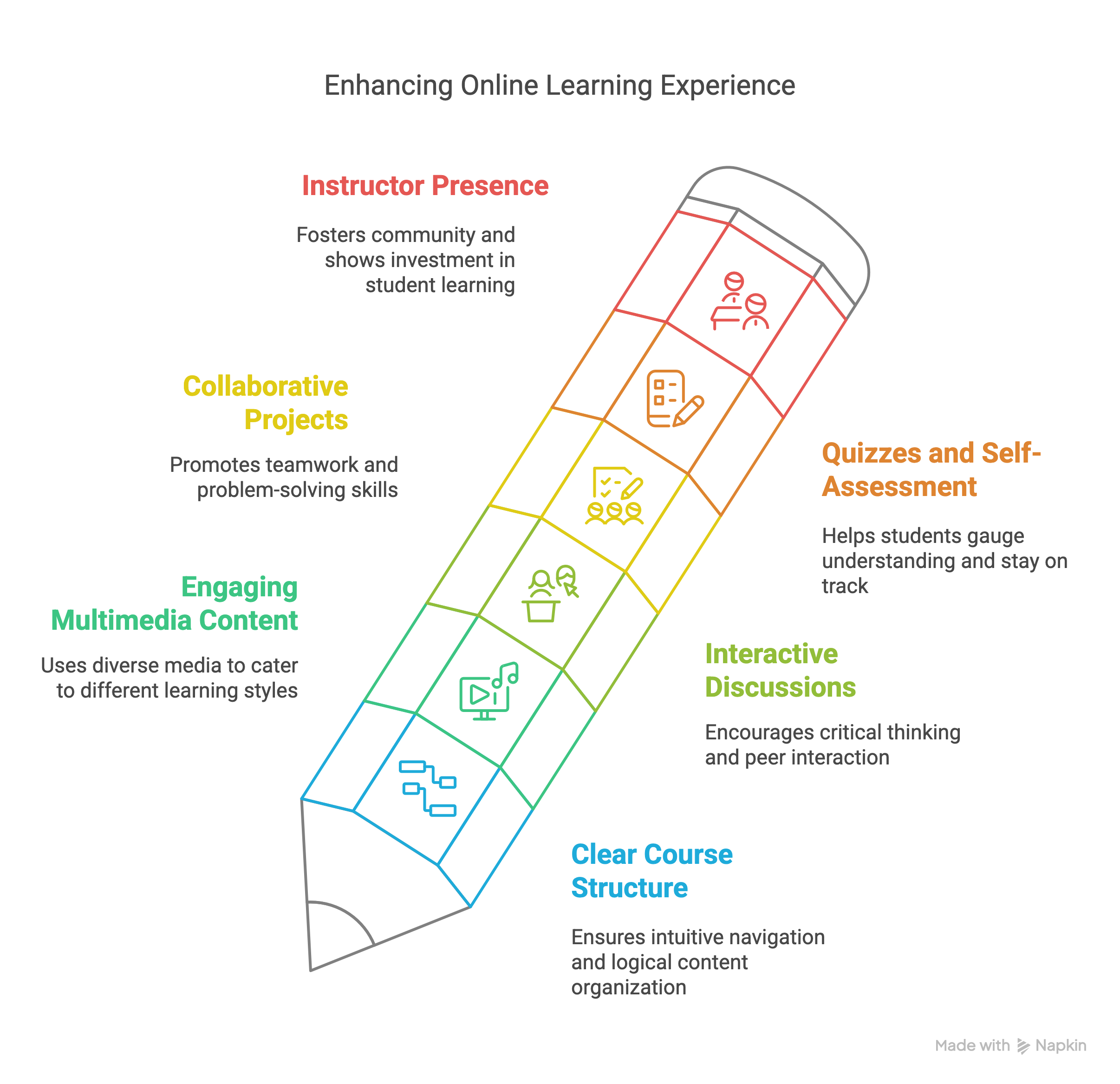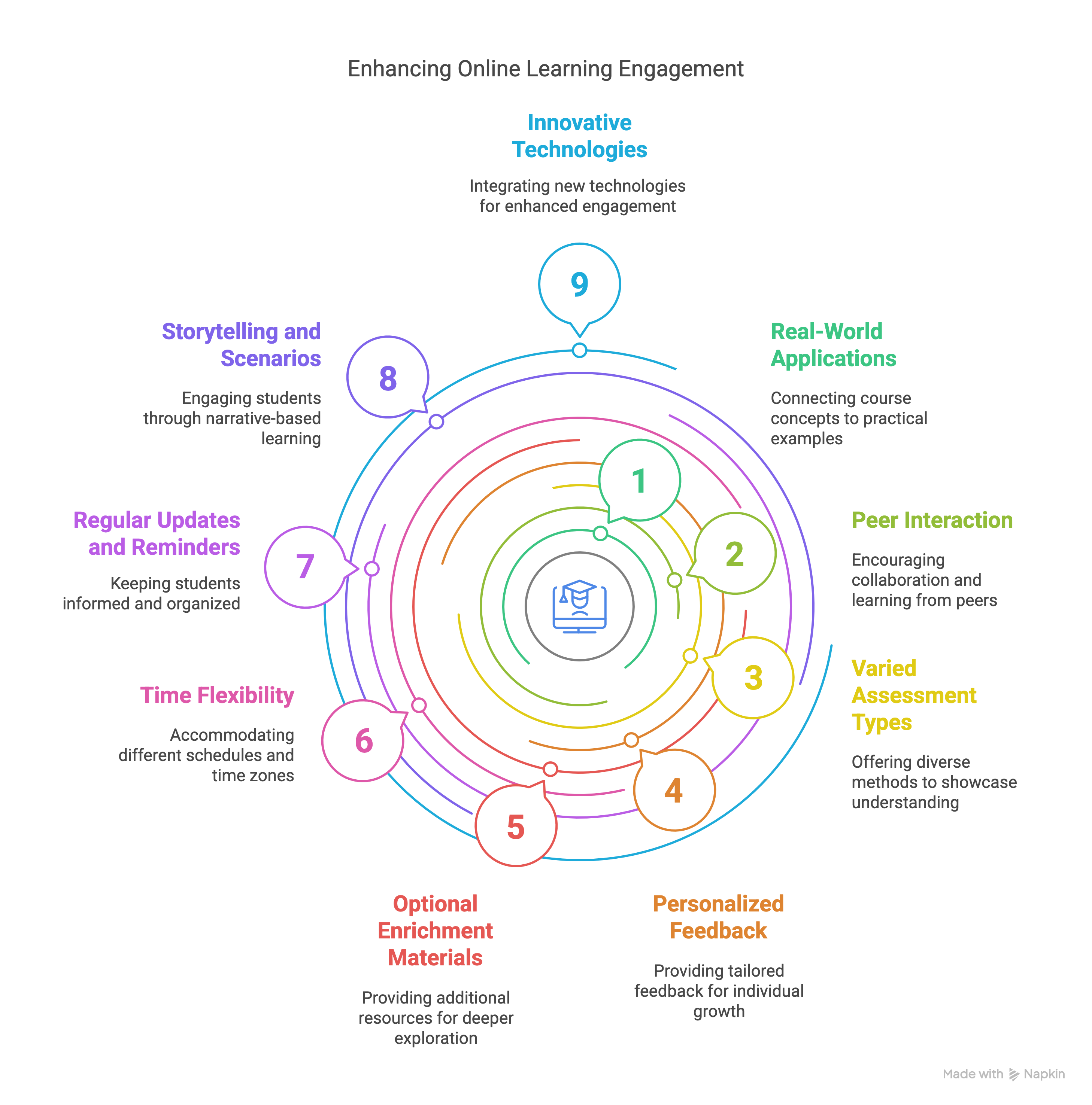Moodle Essentials: Structuring, Sharing, and Supporting Learning
Student Engagement Strategies in Online and Blended Courses
Student engagement in an Asynchronous Online course:
Engaging students in an asynchronous university course can be challenging, but with the right strategies, you can create a dynamic and interactive learning experience. Here are some strategies to consider:
1. Clear Course Structure and Navigation: Ensure that the course layout is intuitive and easy to navigate. Use clear headings, subheadings, and organize content in a logical sequence. Provide a course outline that outlines the learning objectives, assignments, and due dates.
2. Engaging Multimedia Content: Use a variety of multimedia content to convey information, such as videos, audio recordings, infographics, and animations. Visual and auditory elements can make the content more engaging and cater to different learning styles.
3. Interactive Discussions: Set up discussion forums or platforms where students can engage in asynchronous discussions related to the course topics. Pose open-ended questions, case studies, or real-world scenarios to encourage critical thinking and peer interaction.
4. Collaborative Projects: Assign group projects or collaborative activities that require students to work together asynchronously. This promotes teamwork, problem-solving, and communication skills.
5. Quizzes and Self-Assessment: Incorporate regular quizzes or self-assessment activities to help students gauge their understanding of the material. Immediate feedback can enhance learning and motivate students to stay on track.
6. Instructor Presence & Regular Communication: Regularly participate in discussion forums, provide feedback on assignments, and send out announcements. Your active presence can foster a sense of community and show students that you’re invested in their learning journey.
7. Real-World Applications: Connect course concepts to real-world examples, current events, or case studies. Demonstrating the practical relevance of the material can motivate students to engage more deeply with the content.

8. Peer Interaction: Encourage peer interaction through activities like peer review of assignments, collaborative problem-solving, or virtual study groups. Students can learn from each other and feel a sense of belonging.
9. Varied Assessment Types: Include a mix of assessment types, such as essays, quizzes, discussions, projects, and presentations. This caters to diverse learning preferences and allows students to showcase their understanding in different ways.
10. Personalized Feedback: Provide timely and constructive feedback on assignments and assessments. Address individual strengths and areas for improvement to help students progress in their learning journey.
11. Optional Enrichment Materials: Offer optional additional resources or readings for students who want to delve deeper into specific topics. This accommodates varying levels of interest and commitment.
12. Time Flexibility: Remember that asynchronous learning is valued for its flexibility. Be mindful of different time zones and commitments students might have outside of the course.
13. Regular Updates and Reminders: Send out regular updates, reminders about upcoming assignments, and important dates. This helps students stay organized and on top of their coursework.
14. Storytelling and Scenarios: Weave storytelling or scenario-based learning into your content. Presenting information in a narrative format can make it more relatable and engaging.
15. Innovative Technologies: Explore emerging technologies such as virtual reality, simulations, or gamified elements that can add an extra layer of engagement to the course.

Using Moodle Tools for Engaging Students:
Here’s how you can leverage Moodle to enhance student engagement:
1. Discussion Forums: Utilize Moodle’s discussion forums to encourage asynchronous discussions. Create different discussion topics for each module or week, and encourage students to share their thoughts, questions, and insights. Pose open-ended questions to spark meaningful conversations. Discussion forums may work better in some courses than others – be sure to be clear about how many posts are required and by a due date, if references are needed, and if posts are worth a grade.
2. Announcements: Regularly post announcements to keep students informed about upcoming assignments, important dates, and any changes to the course. Announcements create a sense of instructor presence and help students stay on track.
3. Quizzes and Surveys: Create quizzes and surveys using Moodle’s built-in tools. Quizzes can be used for self-assessment or to evaluate understanding, while surveys can gather feedback on the course content and structure.
4. Assignment Activities: Use Moodle’s assignment activities to collect and grade student assignments. Provide clear instructions and rubrics, and encourage students to submit their work electronically. You can also offer peer review assignments to promote interaction.
5. Resource Repository: Populate the resource repository with a variety of content, including documents, presentations, videos, and links to external resources. Diversifying the content format caters to different learning styles.
6. Interactive Content (H5P): Embed interactive elements like H5P activities directly into Moodle. H5P allows you to create interactive presentations, quizzes, and other engaging content types. See examples of what H5P can do https://h5p.org/content-types-and-applications they are interactive activity building blocks. We can build them right in Moodle, or import activities from other H5P ‘libraries’ and modify the activities to suit our needs. :
7. Glossaries: Create glossaries for key terms and concepts. Encourage students to contribute definitions and explanations, fostering collaborative learning.
8. Badges and Gamification: Implement badges to recognize student achievements and milestones. You can also gamify the course by incorporating points, leaderboards, and challenges to motivate participation.
9. Virtual Classroom Integration: Kaltura Classroom is integrated into Moodle, but you could also use Zoom. Schedule virtual sessions for Q&A tutorials, virtual office hours, discussions, or presentations.
10. Group Activities: Use Moodle’s group features to create virtual study groups or project teams. Assign group projects or discussions to foster peer interaction.
11. Feedback and Grades: Provide timely and detailed feedback on assignments using Moodle’s grading and feedback tools. Constructive feedback can motivate students and guide their learning.
12. Analytics and Reports: Utilize Moodle’s analytics and reporting features to monitor student activity. Identify patterns of engagement and intervene if students appear to be disengaged.
13. Guest Speakers and Webinars: Organize guest speaker sessions or webinars and integrate them into your Moodle course. This can provide students with real-world insights and networking opportunities.

External Tools for Student Engagement:
- Hypothes.is is an annotation tool and platform that allows users to collaboratively annotate and highlight web content. It enables individuals, educators, researchers, and students to engage in discussions and provide insights directly on websites, PDFs, and other digital documents. Hypothes.is enhances online reading and fosters a more interactive and social approach to understanding and analyzing information.Key features of Hypothes.is include:
- Annotations: Users can highlight text and add annotations to specific parts of a webpage or document. Annotations can include comments, questions, clarifications, or links to related resources.
- Public and Private Annotation: Annotations can be made publicly visible, allowing for open discussion and collaboration, or kept private for personal notes and references.
- Collaboration: Users can reply to others’ annotations, initiating threaded discussions around specific content. This collaborative approach encourages critical thinking and deeper engagement with the material.
- Tagging and Categorization: Annotations can be tagged with keywords, making it easier to organize and search for specific themes or topics across different documents.
- Sharing: Hypothes.is allows users to share annotated content with others, facilitating knowledge sharing and discussions among peers, students, or colleagues.
- Integration: The platform can be integrated into various websites, online articles, and educational platforms, including learning management systems like Moodle.
- Accessibility: Hypothes.is strives to be accessible to individuals with disabilities, ensuring that all users can engage with annotated content.
- Research and Education: Hypothes.is is widely used in educational settings for collaborative reading, peer review, and discussions. It’s also employed by researchers to annotate academic papers and engage in scholarly conversations.
- Fact-Checking and Verification: Annotations can be used to provide additional information, sources, or corrections to online content, contributing to a more informed online environment.
- Open Standards: Hypothes.is is built on open standards, allowing for interoperability with various platforms and tools.
Hypothes.is provides a platform for digital literacy and critical engagement with online content. It encourages active reading, deeper comprehension, and the sharing of diverse perspectives. Whether for scholarly research, educational purposes, or personal reading, Hypothes.is offers a way to interact with digital information in a more meaningful and interactive manner.

